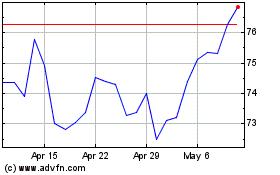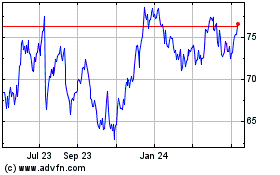By Donna Borak
WASHINGTON -- The federal fund that protects consumers' U.S.
bank deposits reached its highest level since the financial crisis,
surpassing a key threshold that means relief for many smaller
lenders that pay into it.
On Tuesday, the Federal Deposit Insurance Corp. said its
deposit-insurance fund stood at $77.9 billion at the end of the
second quarter and its insurance fund reserve ratio surpassed a
critical threshold of 1.15% of the institutions' estimated insured
deposits.
The growth of the fund, which is made up of premiums collected
from banks, means that the 93% of institutions that have less than
$10 billion in assets will pay less into the fund starting in the
current quarter than they did before. All banks were required to
pay a premium until the deposit fund surpassed the 1.15% threshold
mandated under the 2010 Dodd-Frank financial overhaul law. Under
the law, once the threshold is surpassed, smaller banks get to pay
less.
Additionally, the number of financial institutions on the FDIC's
"problem list" shrank to 147, the lowest in more than seven years.
Two banks failed during the second quarter.
Tuesday's figures contrast with the fund's $20.9 billion deficit
at the end of 2009, as a flood of bank failures squeezed agency
resources. At the time, the depletion of the agency's fund stoked
fears the FDIC might need to tap its credit line with the Treasury
Department.
"This marks a significant milestone for the fund, which fell
into negative territory following the financial crisis," said FDIC
Chairman Martin Gruenberg.
The Dodd-Frank law requires the fund to reach a minimum ratio of
1.35% by the end of the third quarter of 2020. It mandates that
banks with $10 billion or more in total assets bear the cost of
increasing the reserve ratio from 1.15% to 1.35%. The reserve ratio
was 1.17% on June 30, the FDIC said.
Earlier this year, the FDIC approved a rule imposing a surcharge
on large banks. Those banks will have to begin paying quarterly
surcharges, in addition to lower regular risk assessments, starting
in the third quarter.
The agency projects the reserve ratio will reach 1.35% in 2018,
at which point the FDIC will stop collecting surcharges on large
banks.
The disclosure came on the same day that the FDIC released its
report card for the nation's commercial banks and savings
institutions, which reported a 1.4% year-over-year rise in net
income in the second quarter.
"The second quarter was a solid one for banks as lending rose
sharply to meet increased demand," said James Chessen, chief
economist for the American Bankers Association, a trade group
representing the country's banks. "With interest rates still far
below normal, loan demand was strong practically across the board.
While loan growth was a key earnings driver, noninterest income
also played an important role, boosted by a strong increase in
trading revenue."
Gains in noninterest income were driven by a 25% rise in trading
income from the year-ago period to $1.4 billion, offsetting a 74%,
or $3.4 billion, decline in servicing income in the most recent
quarter.
Net income at the 6,058 banks insured by the FDIC rose $584
million to $43.6 billion in the second quarter from $43 billion a
year earlier, according to the agency.
"Income and revenue both increased from a year ago, loan growth
remained strong, the number of unprofitable banks was at an 18-year
low, and there were fewer banks on the problem list," Mr. Gruenberg
said, noting that community banks' revenue, income and lending
continues to improve.
The rise in net income was in part because of a $5.2 billion
increase in net interest income and a $981 million decline in
expenses for litigation put aside at a few large banks, including
J.P. Morgan Chase & Co., Citigroup Inc. and State Street Corp.
Banks also increased their loan-loss provisions by 44% from a year
earlier to $3.6 billion, driven in part by rising levels of
troubled loans to commercial and industrial borrowers in the energy
sector.
In the second quarter, the number of loan payments by commercial
and industrial borrowers that were past due rose 8.9% to $2.1
billion, as low energy prices continued to challenge oil and gas
producers. Mr. Gruenberg reiterated that the full impact of low
energy prices remains to be seen on the banking industry.
"Banks are still operating in a challenging environment," he
said. "Net interest margins and return on assets remained low by
historical standards, noncurrent commercial and industrial loans
increased, and loan charge-offs rose for a third consecutive
quarter."
Community banks, which account for 5,602 of the insured
institutions, fared better than the industry overall, reporting a
9% rise in earnings in the second quarter to $5.5 billion. Net
operating income in the quarter rose 7.1% to $22.8 billion from the
second quarter of 2015. Those banks have continued to hold larger
shares of longer-term assets on their balance sheets compared with
the rest of the industry, according to the agency. Doing so helps
them sustain their net interest margins in the low-interest-rate
environment.
Write to Donna Borak at donna.borak@wsj.com
(END) Dow Jones Newswires
August 30, 2016 19:27 ET (23:27 GMT)
Copyright (c) 2016 Dow Jones & Company, Inc.
State Street (NYSE:STT)
Historical Stock Chart
From Mar 2024 to Apr 2024

State Street (NYSE:STT)
Historical Stock Chart
From Apr 2023 to Apr 2024
